Executive Summary
The Social LED flashboard is an illuminated sign board that can be marketed in the Chinese, Australian, US, and EU markets. The objectives set include entering the markets of Australia, the USA, and the EU since the Chinese market is overly saturated. At that, it is also planned to increase the share in the Chinese market within three years. These objectives will be achieved through the change in product, price and promotion methods. Thus, the price will remain the same, but the additional value will be introduced (customization, increased energy efficiency, stencils, and so on). As for the promotion strategies, the wide advertising campaign will be launched in China and the other target markets through online tools and such promotional activities as participation in expos, discounts and so on. This report includes a detailed description of the action plan including the budget.
Introduction
The product in question is the Suocai LED flashboard, which is the latest modification of illuminated signs blackboard LED with the acrylic panel. Its size (70x50cm) with the writing area of 66x46cm can be customized (see fig. 1). The acrylic panel is inserted into the aluminum alloy frame (Shenzhen Suocai Electronic Technology Co 2015). The light source is LED RGB 5050 with 36 different flash modes. It also has a remote controller. The board is mainly used in such areas as dining, entertainment nightspots, retail stores, events, and even education. Therefore, it is clear that this is mainly a B2B product, but it can also be sold to individuals.
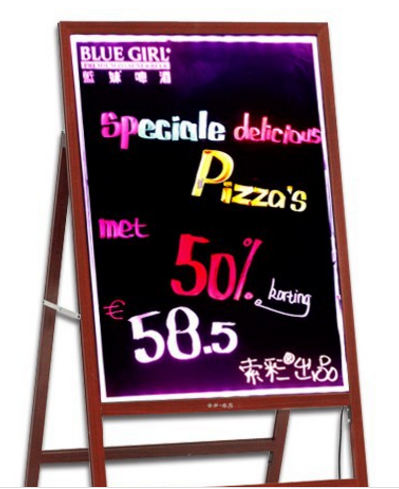
Some of its major features are as follows:
- Re-writable: unlimited use
- Flexible writing method: the user can communicate any messages through notes and pictures
- Bright effect: inscriptions made with fluorescent marker pens that are provided in multicolor and can be controlled
- Eco-friendly
- Low power consumption
The product has the following certification: RoHS and CE. It is characterized by 100,000 hours’ life span and the one-year warranty. The cost for the product ranges between $11.22 and $53.33.
Current Situation
To consider the current situation in the market and prospects of the product in question, it is necessary to analyze the position of the board on the macro and micro levels (Gupta 2013). When it comes to the macro environment, the use of the PEST model is beneficial as it allows to consider major factors affecting the product under analysis. As far as the microenvironment is concerned, Porter’s Five Forces model can be employed. Barrows and Neely (2012) claim that these two approaches enable the researchers to obtain detailed information on the current situation and provide recommendations on product marketing.
Macro Environment: PEST Model
The PEST model is commonly used by researchers to assess the macro environment of the product. It consists of the analysis of the following factors: political, economic, socio-cultural, and technological (Gupta 2013).
Political Aspect
China
It is necessary to note that light-emitting diode (LED) technology is associated with environmental benefits concerning reduced CO2 emissions and energy consumption. It is noteworthy that the major part of the energy consumed in China (66%) is coal supplied, which adds to the environmental issues. For example, in 2012, the country released more than 8 million metric tons of CO2 (China: international energy data and analysis 2015). The Chinese government is committed to reducing the country’s energy consumption and CO2 emissions. Thus, according to the 12th Five-Year Plan (2011-2015), China intends to decrease carbon intensity by 17% and energy intensity by 16% (China: international energy data and analysis 2015).
The Chinese government also plans to reduce greenhouse gas emissions by 40% by 2020. Therefore, the government also supports industries that produce efficient products. Zhu (2013) notes that 12% of the electricity consumption falls on general lighting. It is also necessary to add that China is one of the leading consumers of electricity with a value of 4,432,900,000,000 (see Fig. 2) (Electric power consumption n.d.). The Ministry of Science and Technology plans to develop the LED lighting industry that will cost more than $80 billion by 2015 (Zhu 2013). At present, the Chinese government subsidizes LED producers (Zhu 2013). There are tax breaks and cheap land for facilities as well.
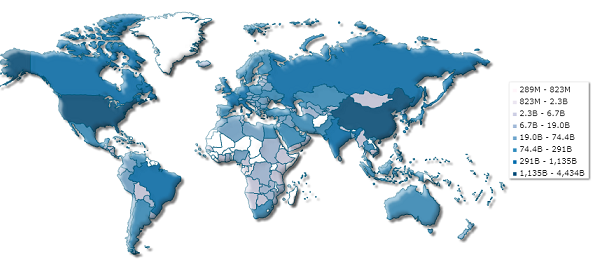
EU and USA
It is necessary to note that the LED technology is politically supported in many countries worldwide. Thus, the EU countries, the USA and Australia have particular programs aimed at the development of the LED industry and replacement of conventional lighting technologies with LED products. For example, according to the ‘Digital Agenda for Europe’ produced by the European Commission, LED technology is seen as an appropriate lighting solution that will help European countries reduce energy consumption (Schulte-Römer 2012/2013). Australia announced its goal to replace all inefficient bulbs with CFLs.
The country also invests in the development of LED technology. American cities are also replacing municipal lighting with more efficient technologies including LED products (Brown 2013). More than 8% of general lighting in North America is already LED-based (Zhu 2013). It is noteworthy that the USA is one of the leading consumers of the electric power (see Fig. 2). The US government is committed to the use of the LED technology that is regarded as an efficient solution in the Energy Independence and Security Act of 2007 (Brown & Kim 2015). Clearly, there is a vivid political support of the industry in the countries mentioned above.
Economic Aspect
China
It is necessary to note that the LED industry is seeing significant growth worldwide due to political support, societal trends, and economic benefits. However, when it comes to the Chinese market, the situation is slightly different. Although the industry is subsidized by the government, the market is saturated as, since the dawn of the LED technology, many companies entered the business, which led to significant competitiveness in the sphere. The saturation of the market led to significant constraints for more than ten leading LED producers. Zhu (2013) states that Ledman Optoelectronic Co Ltd lost 48% while another leading LED producer Shenzhen Unilumin Group Co Ltd lost 37%. Notably, such world leaders as Phillips or Siemens may win a significant share of the Chinese market.
It is also necessary to add that the cost of LED products plays a significant role in its popularity (Brown & Kim 2015). However, the country’s growth is slower than expected, and the buying capacity of people is reducing (Magnier 2015). Thus, many businesses are witnessing certain difficulties and have limited resources to innovate. At that, Magnier (2015) states that the retail sector is still growing steadily with more than a 10% increase (see Fig. 3). Wildau (2015) states that such growth is due to such areas as healthcare, education, whereas the entertainment sector is steadily growing. For instance, the box office revenue increase by almost 50% (Wildau 2015).
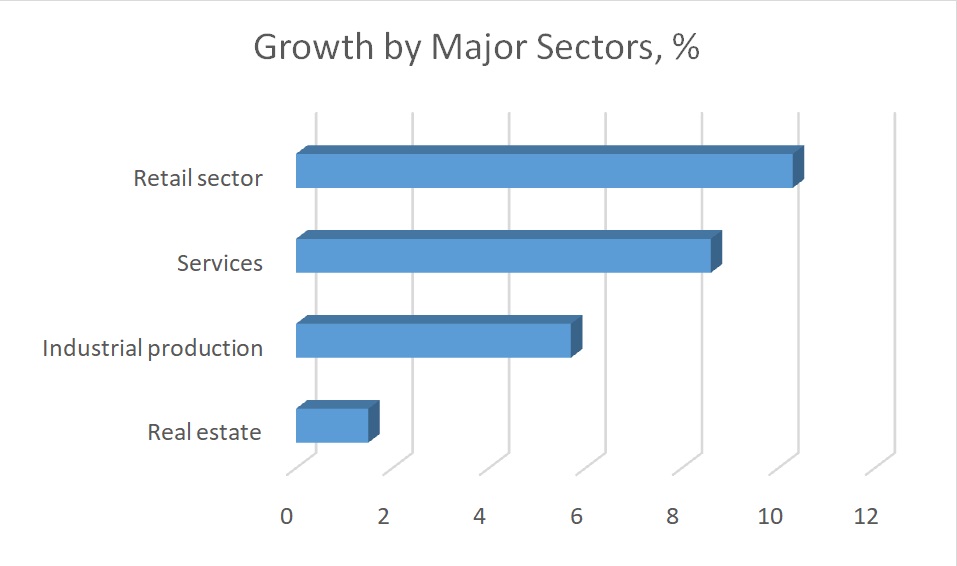
Global Market
As far as the global market is concerned, it is necessary to note that the EU countries, the USA and Australia have not recovered from the financial crisis of 2008. However, the growth in the economies of these countries is apparent. For instance, the growth rate in the UE countries exceeded the corresponding rate of 2009.
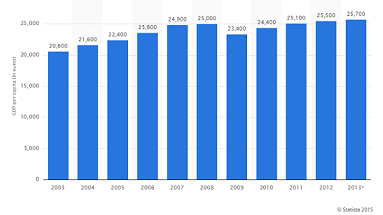
When considering the prospects of the product in question, it is essential to pay special attention to the sector of services since this is the area where it can be mainly used. Importantly, the services sector accounts for around 70-80% of GDP. In China, this share is significantly lower (see Fig. 5).
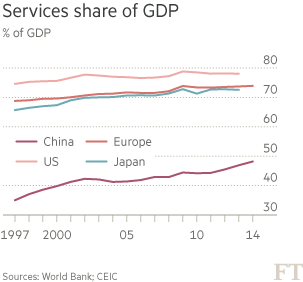
Socio-Cultural Aspect
As has been mentioned above, the services sectors in the largest economies are increasing steadily. People are ready to spend their money, and advertising starts playing the central role in attracting customers. In China, businesses choose bright outdoor advertising as a tool to attract more customers (Brown & Kim 2015). It is regarded as a cost-effective means as LED signs consume less energy. LED signs are bright, and it is possible to communicate the necessary message. Importantly, smalls businesses want to follow the global trend and be innovative. LED technology is a good opportunity to do that.
Technological Aspect
The product is innovative and addresses the needs of businesses concerning advertising. However, Suocai LED flashboard can be improved. These improvements may address the energy consumption. As has been mentioned above, the competition in the market is very intense. Therefore, the product should have competitive characteristics. LED product producers tend to develop more energy-efficient items and reduce costs (Stafford 2010).
It is beneficial to make the product portable. The use of batteries can be the first step in this direction. The product complies with certain standards and the CE and RoHS certification can be regarded as a competitive advantage. However, it can also be important to obtain the ISO standards certification to make customers aware of the particular quality of the product in China as well as worldwide.
Microenvironment: Porter’s Five Forces
Supplier Power
China’s central segment of the economy is manufacturing. Therefore, the suppliers can be easily found. Such components as the frame or the back panel can be easily produced. One of the most important components of the product is the semiconductor, which makes up the most significant part of the product’s cost. More so, it has been estimated that the semiconductor market grew by more than 30% in 2010 and continued its growth (Continued growth: China’s impact on the semiconductor industry 2011). The largest providers of semiconductors in China (as well as worldwide) are Intel, Samsung, Hynix, Toshiba, TI, and ST. Clearly, there are many other smaller producers.
Buyer Power
As far as the buyer power is concerned, it is possible to note that the sector of services (especially entertainment) is growing steadily. As has been mentioned above, the service share in China is only 40-50%. At that, the share of export and import services is quite different (see Fig. 6) (China 2015). It is also necessary to add that it is difficult to identify the share of different types of services within the ‘other services’ indicator (Wildau 2015). However, it is known that these include healthcare, education, MGM industry, cinema, and so on. Importantly, these are spheres where the product in question can be effectively utilized. Therefore, it is clear that the buyer power is also very high since the corresponding industries are developing and owners of industries are likely to invest in advertising.
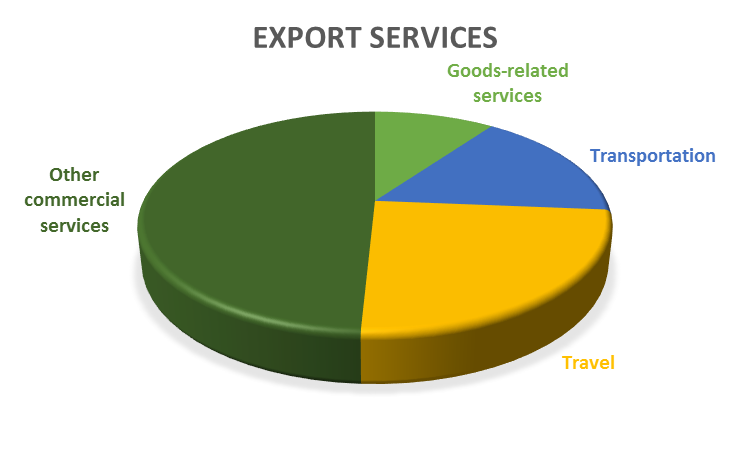
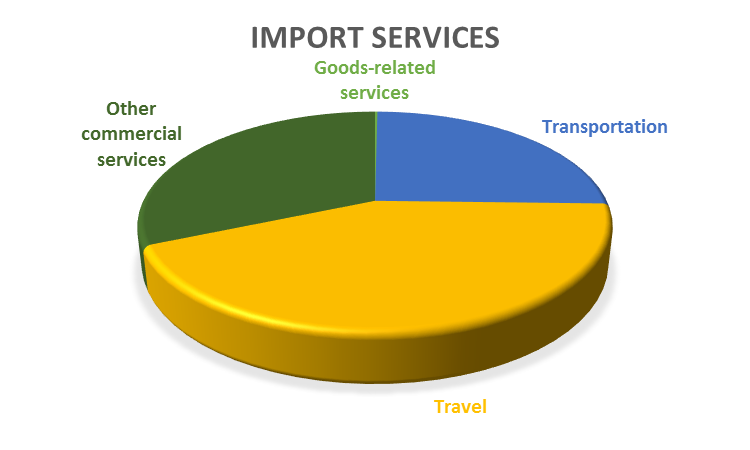
Competitive Rivalry
As has been mentioned above the Chinese market of LED items is saturated. This is also true for LED boards. Some of the leading producers in the Chinese market are Changzhou Trisun Starlight Manufacturing Co. Ltd, Beinuo Lighting Co. Ltd, Yuchi Industrial Limited, Shenzhen Bomaxs Opto-Electronic Co. Ltd, and so on (Europages 2015). These companies provide a wide range of product including various types of LED boards.
As for the global market, Hu et al. (2015) note that five leading global producers of LED products are Osram, Nichia, Cree, Philips, Toyota dominate the global market with a market share of almost 40% in 2009. However, it is also important to stress that the majority of companies operating in the global market are mainly focused on the production of LED lighting (bulbs, street lights and so on). Therefore, the global market can be a potential target for the product in question.
Threat of Substitution
When it comes to the threat of substitution, the product is innovative and, hence, there is always a risk that more conventional products will be preferred. Thus, there are high chances that business owners will employ conventional blackboards due to their low price. Some business owners may prefer old ways and use blackboards instead of the LED signboard.
Threat of New Entry
As has been mentioned above, the competition is significant, and many companies operate in the market of LED products. New companies appear in the Chinese market due to various policies aimed at the development of the LED industry. More so, world-leading producers of LED technologies may easily start producing LED signboards and enter the Chinese market. This will lead to significant difficulties in the successful marketing of the product in question.
Key Issues
To assess key issues the product may face, it is possible to implement a brief SWOT analysis. The SWOT analysis includes such elements as strengths, weaknesses, opportunities, and threats (see Fig. 7).
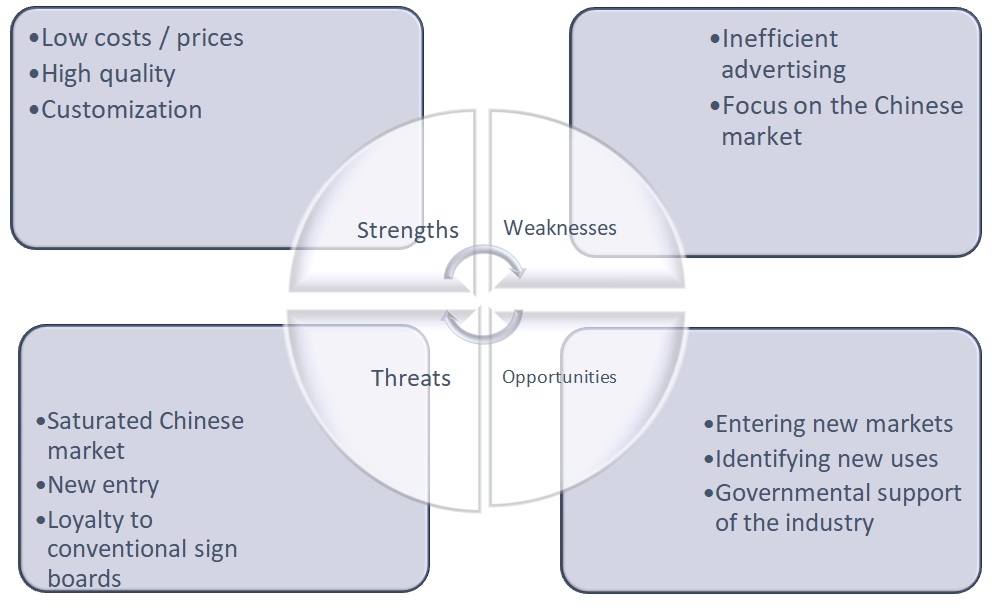
Internal Factors
As far as the strengths of the product are concerned, it is possible to note that the cost of the production is quite low, which enables the producer to offer a good price. This is one of the most significant advantages of the product as business owners may find it a good investment as they receive an efficient advertising tool at a good price. They do not need to spend too much money, and they can replace their old blackboards with more innovative signboards.
Another significant strength of the product is its high quality. Quality allows the producer to develop some reputation and attract new customers as well as sell to loyal ones. Another important strength is customization. The product can be customized if needed. This may involve the change of the size or color of the frame. This is quite important as all businesses are different and may need different advertising items.
As for the weaknesses of the product, it is possible to note that the marketing approach is rather ineffective. The lack of advertising results in low awareness about the product. This can, eventually, result in the success of rivals whose products will be advertised more intensely. It is necessary to note that the product can be found at various websites associated with online sales (eBay, Alibaba, and so on). This is a good channel, but it is not sufficient in the contemporary business environment. Furthermore, although it is noted that the export markets are Asia, Australia, North America, Central/South America, Eastern Europe, Mid East/Africa, and Western Europe, the product is aimed at the Chinese market (Shenzhen Suocai Electronic Technology Co 2015). This is a significant weakness as the Chinese market is saturated.
External Factors
When it comes to opportunities, it is possible to note that the product can be further developed and improved as the industry has the governmental support (China: international energy data and analysis 2015). Thus, the company can relocate some funds to invest in the development of the product (increasing its capacity, decreasing its energy consumption, and so on). Apart from that, the product can become more popular if all the uses, as well as new applications, will be properly advertised.
Of course, the product is mainly associated with the MGM industry. However, it can also be used in education and healthcare. Teachers can find this tool very helpful as it can lead to increased motivation in pupils. Hospitals can use the flashboards to improve the quality of services provided. Apart from better navigation across the healthcare unit, the boards can be used to encourage a particular behavior. Hence, the board can remind patients to take pills or keep to a diet. It can also remind healthcare professionals to perform proper hand hygiene procedures and so on.
The flashboard is positioned as mainly a B2B product. However, it is also possible to target individual households as people can buy the boards for such special occasions as weddings, birthday parties, various celebrations and so on. Finally, the product can enter new markets, which is a good opportunity for the flashboard. The primary markets will be the USA, Australia, and the EU countries. People in these areas are environmentally conscious, which can be used in the marketing strategy. More so, the entertainment industry is well-established, and services account for up to 80% of the countries’ GDP (Wildau 2015). Therefore, the LED board can become a popular advertising tool used in many spheres.
As far as threats are concerned, it is possible to outline the following issues. The Chinese LED market is overly saturated, and the competition is very intense. Similar products are available through various distribution channels. Competitors also offer quite low prices and some features that are not present in the product in question. For instance, Shanghai Liyu Optoelectronic Co. provides a wide range of LED signboards including battery-powered ones (Shanghai Liyu Optoelectronic Co 2015).
Another threat is a new entry as well-established brands can start producing similar products on a large scale. Such companies as Philips and Siemens are acknowledged as well-established high-quality brands, and people are likely to buy from these companies rather than smaller producers. Apart from that, the industry is supported by the government, and it is quite easy to enter it (Zhu 2015). Hence, smaller businesses can be launched, which will contribute to the intensification of the competitiveness. Finally, it has been acknowledged that people may stick to old ways and remain reluctant to buy innovative products. This threat is also quite strong as many people think that conventional products are more reliable, stylish and appropriate. (A short conversation with several owners of small restaurants and hotels reveals many people’s preference to use conventional blackboards as they are ‘stylish’, ‘cheap’, ‘convenient.’ At that, it is necessary to note that some are unaware of the features of LED flashboard signs (price, energy consumption, and so on)).
Objectives
It is possible to develop a three-year marketing plan that will help market the product and accomplish the objectives outlined (McDonald 2009). Three years will be the necessary period to implement a new strategy aimed at penetrating new markets, increasing revenue and winning a certain share of the Chinese market. The major objectives can be formulated as follows.
- Obtain a 10% share in the Chinese market.
- Enter the markets of Australia, the USA, and the EU countries.
- Increase the revenue by 40% during the three years.
Marketing Strategy
To develop an efficient marketing strategy, it is possible to employ the STP model. It will allow identifying major targets, and it is also a good foundation for the advertising campaign (O’Guinn et al. 2014).
Segmentation
One of the first steps to undertake is concerned with segmentation. It is essential to identify the most appropriate market for the product. The Chinese market should be the primary target for the product in question. The services sector of the Chinese market is increasing, and, therefore, such spheres as MGM and entertainment will need various advertising tools (Wildau 2015).
However, it is also necessary to note that the Chinese market is overly saturated, which makes expansion essential. Entering the Australian, American and European markets is important for the development of the product. The market segmentation will help identify the major focus of the marketing effort (see Table 1). The most common categories include geographic, demographic, behavioral and psychographic (Ferrell & Hartline 2012).
Table 1: Segmentation.
Targeting
Companies may choose different targeting strategies including single-segment, selective, mass market, product specialization, and market specialization (Ferrell & Hartline 2012). In this case, the product specialization is the most appropriate method to employ as it enables one to market one product in different markets. It is necessary to note that the product will be marketed mainly as a B2B item, but it will be also marketed to individuals. As has been mentioned above, several regions will be targeted. The major market will be China since this is the place of the item’s production, as well as due to the governmental support and the development of the corresponding sectors of the Chinese economy (Zhu 2013).
The USA will be the first market to penetrate as there are well-established trade links and distribution channels between the two countries. Australia and the EU countries will be the final markets to enter during the three years. The product will be most valued in cities with more than 100,000 people. In such places, the services sector is the most developed. Clearly, urban areas are appropriate for the product in question as these are places where most services are provided.
When articulating the message to potential customers, it is necessary to target people about the middle class as well as the lower class. These are owners of medium and small businesses. The product will be useful for this category. The age of potential customers will be between 25 and 50 years old. Business owners are usually older than 25. At that, those older 50 are likely to stick to old ways and traditions (Richter 2012).
Such innovative products as the LED flashboard can be regarded as something unnecessary. However, when addressing individuals, this group should be expanded to people between 18 and 50 years old. Young people can use the product for learning purposes (reminders, notes, schedules) and special occasions (parties, weddings, ceremonies and so on).
When targeting business owners, it is essential to remember that the major motives for them are the convenience, profit, and status. These people need to promote their business, and they see advertising tools as a way to gain as well as maintain a certain status, attract new customers and appeal to loyal ones. Of course, personality features should also be taken into account. Thus, outgoing, venturesome and materialistic people will be most responsive as these features reveal people’s need to innovate and develop.
Finally, behavioral segmentation provides insights into the way the product can be used, and, hence, advertised. The potential customers (business owners) expect that the advertising tool such as the LED flashboard will be associated with the following benefits: quality, convenience, promotion. The product should also be convenient and help increase the profit. Importantly, potential customers are price-sensitive, which should be taken into account. Medium and small business owners are ready to spend rather limited funds to develop and innovate. Importantly, these people are value-conscious as they expect to receive particular gains after their investment. As has been mentioned above, apart from business purposes, the product can be utilized during parties, various celebrations. Everyday use is also possible.
Positioning
It is possible to identify the major characteristics of the product that will help position it (see Fig. 8). Clearly, customers need lower prices as they are often reluctant to invest significant funds to innovate and develop their business, especially if it is going well. Quality is one of the most important features of customer value. They want to be sure that they obtain good value for their money. They should acknowledge the positive effect of the LED flashboard on their business (attraction of new customers). The customers should also understand that the money invested will soon pay off. The product should also have the necessary features that meet the customers’ needs. These features will include size, color, energy consumption, portability. Finally, the product should also appeal to people’s emotions. This is mainly associated with the individual use of the product.
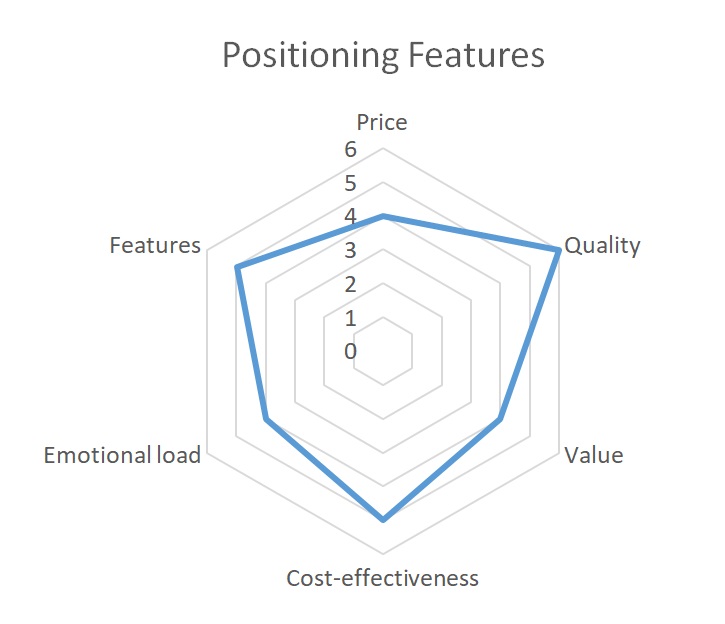
Action Plan
It has been acknowledged that the marketing mix is one of the most effective ways to develop an efficient action plan. At that, an efficient marketing mix should address the target markets outlined (Lamb, Hair & McDaniel 2011). The LED flashboard will be sold to business owners and individual customers. Clearly, the focus will be made on the B2B format. However, the personal use of LED signboards is limited, which offers a possible niche to occupy. It is necessary to note that the difference between the two markets is not significant.
Product
It is necessary to note that the difference between the two markets in China, Australia, the USA, and the EU countries is insignificant. Therefore, the focus will be made on the difference between such domains as B2B and individual customers.
B2B
The product is an important element of the marketing mix that involves the “goods-and-services combination” (Kotler & Armstrong 2010). Thus, the flashboards should be energy efficient. Business owners are conscious about the use of electricity and may prefer utilizing conventional blackboards to save money. The LED flashboards should be high-quality products that can be customized to the customer’s needs. The size and color are major adjustable features. It can be a good idea to provide several stencils since some business owners may feel they lack creativity. The stencils should also be customized. For example, names, logos, brand names can be provided for some extra fee or free of charge to loyal customers. The product should also be certified properly.
This is especially important when entering the US, EU and Australian markets as ISO certification can be an advantage in these markets. A brief survey shows the attention potential customers pay to major features (see Fig. 9)(the survey involved brief questionnaires covering 20 small business owners). Thus, the price seems the most important feature business owners pay attention to. Promotional capacity and energy efficiency are almost equally valued as these features have a significant impact on the wellbeing of the business and show the cost-effectiveness of the promotional tool, LED sign flashboard. Certification is also valued as it is seen as a sign of the quality of the product.
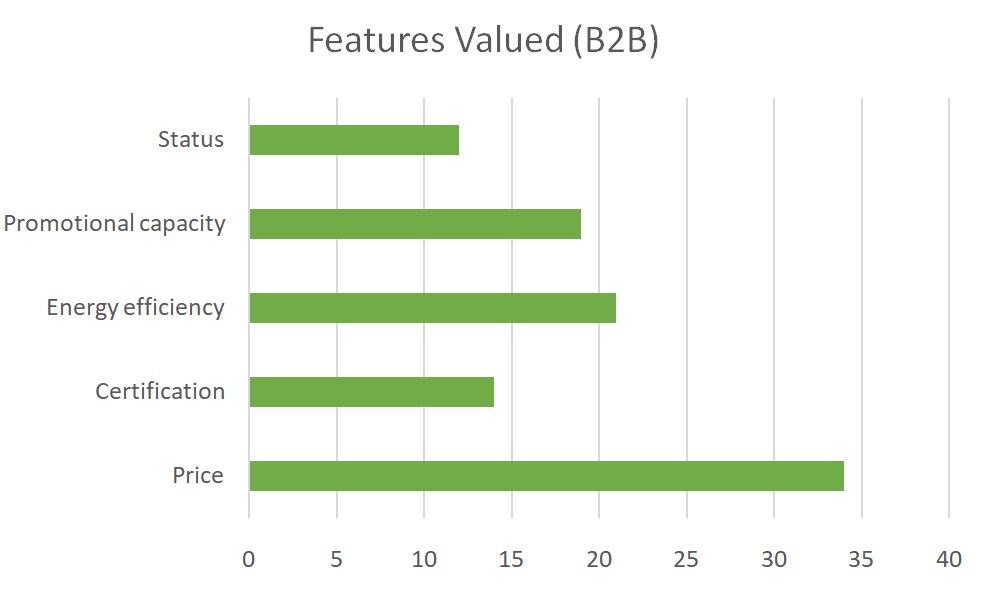
Individual Users
When it comes to individual users, the major features can be portability and size. Individual users will prefer smaller boards that can be portable (using batteries). They will be able to use them during outdoor activities or moving across the house. It is also possible to provide some stencils for major celebrations ideas (Happy Birthday, Just Married, and so on). The features valued in this segment are slightly different (see Fig. 10)(the survey involved 20 peers completing brief questionnaires). Potential customers do not focus on energy efficiency. However, the primary focus is made on price.
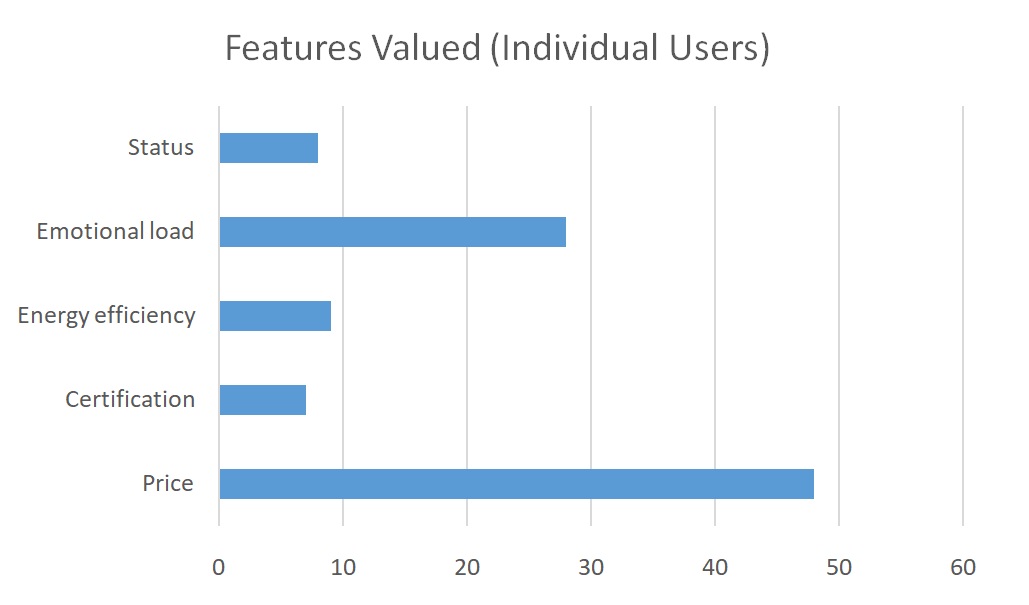
Price
The analysis of potential customers’ preferences shows that price is the essential feature. Therefore, it is crucial to pay major attention to the price category. It is necessary to note that the objectives concerning the Chinese market and other markets are quite different, so different strategies should be utilized.
Chinese Market
As has been mentioned above, the Chinese market is overly saturated. Hence, it is possible to employ the penetration-pricing strategy that will help obtain a larger share of the market (Smith 2011). The strategy involves setting lower prices, but it is also possible to keep the price and provide more features or services associated with it. The price for the LED flashboard is between $11-53, and it depends on the size and some modifications. However, it is possible to add such features as stencils, additional colorful frames. When marketing the product, it will be essential to stress the availability of certification (ISO, for example). It is also necessary to focus on energy efficiency and compare it to other products available in the market.
Other Markets
Another strategy should be employed when dealing with other markets. The price-neutral positioning will allow introducing the product in new markets (Smith 2011). The competition in these markets is less severe. More so, the prices are significantly higher which makes the product competitive. For instance, in the USA, it is possible to buy LED flashboards online at the prices ranging from $30 to $300 and higher (eBay 2015). At that, the product will go with additional features including batteries, increased energy efficiency, and stencils.
Placing
Another component of the action plan is placing. When it comes to distribution channels, it is possible to collaborate with distributors and launch online sales. Importantly, these strategies can be used in all the target markets, Chinese and other markets. This will ensure a certain reduction in costs.
Promotion
Product awareness is very low, and, hence, the wide advertising campaign is necessary. One of the basic channels used will be the Internet. Social networks will be heavily used in the US, EU, and Australian markets. Online advertising will be also employed in these markets and China. These platforms are effective when targeting the B2B and individual customers. It is possible to provide promotional items to hospitals and educational establishments as well as MGM companies to raise awareness about the product. This is especially true for markets other than Chinese. In China, it is important to use print sources and such media as TV to promote the product.
It is essential to focus on such aspects as innovation, efficiency, and emotional load. When targeting B2B, the advertisements and promotional materials should concentrate on efficiency, price, and benefits for business (attracting new customers). While targeting individual buyers, it is necessary to draw customers’ attention to the price, convenience and emotional load (having fun with friends and close ones).
Budget
The budget for the three-year plan involves investment in the development of the product and promotion (see Table 2). The overall payoff of this strategy will be $700,000. What is more, the product will enter other markets and will obtain a significant market share in China.
Table 2: The Budget for the Action Plan.
Controls
The effectiveness of the strategy will be implemented through the analysis of sales, product/brand awareness, and customers’ feedback. This will enable the top management to evaluate flaws in the plan if any and effectively diminish them. The working team will be created. The team will be cross-functional and will include professionals from all major departments. The group will be responsible for the development of a detailed action plan and its implementation and evaluation.
Reference List
Barrows, E & Neely, A 2012, Managing performance in turbulent times: analytics and insight, John Wiley & Sons, Hoboken, NJ.
Brown, L 2013, ‘Stabilizing climate: an energy efficiency revolution’, in M Winston & R Edelbach (eds), Society, ethics, and technology, Cengage Learning, Boston, MA, pp. 397-415.
Brown, MA & Kim, G 2015, ‘Energy and manufacturing: technology and policy transformations and challenges’, in JR Bryson, J Clark & V Vanchan (eds), Handbook of manufacturing industries in the world economy, Edward Elgar Publishing, Northampton, MA, pp. 121-147.
China 2015. Web.
China: international energy data and analysis 2015. Web.
Continued growth: China’s impact on the semiconductor industry: 2011 uptake 2011. Web.
eBay 2015. Web.
Electric power consumption n.d. Web.
Europages 2015. Web.
Ferrell, OC & Hartline, M 2012, Marketing strategy, Cengage Learning, Mason, OH.
Gupta, A 2013, ‘Environmental and pest analysis: an approach to external business environment’, Merit Research Journal of ART, Social Science, and Humanities, vol. 1, no. 2, pp. 13-17.
Hu, MC, Phillips, FY, Wu, CY & Wang, SH 2015, ‘The influence of the technological regime on the global light-emitting diode industry: lessons from innovative leaders and latecomers’, Innovation, vol. 17, no. 1, pp. 91-114.
Kotler, P & Armstrong, G 2010, Principles of Marketing, Pearson Education, New York, NY.
Lamb, C, Hair, J & McDaniel, C 2011, Essentials of marketing, Cengage Learning, Mason, OH.
Magnier, M 2015, ‘China economic growth falls below 7% for first time since 2009’, The Wall Street Journal. Web.
McDonald, M 2009, Marketing plans: how to prepare them, how to use them, Elsevier, Burlington, MA.
O’Guinn, T, Allen, C, Semenik, R & Scheinbaum, AC 2014, Advertising and integrated brand promotion, Cengage Learning, Stamford, CT.
Per capita gross domestic product (GDP) in the European Union. 2015. Web.
Richter, T 2012, International marketing mix management: theoretical framework, contingency factors and empirical findings from world markets, Logos Varlag Berlin GmbH, Berlin.
Shanghai Liyu Optoelectronic Co., Ltd. 2015. Web.
Shenzhen Suocai Electronic Technology Co., Ltd. 2015. Web.
Schulte-Römer, N 2012/2013, ‘Digitalizing urban lighting technological change raises political issues by transforming city spaces’, WZB, vol. 1, pp. 28-30. Web.
Smith, T 2011, Pricing strategy: setting price level, managing price discounts and establishing price structures, Cengage Learning, Mason, OH.
Stafford. N 2010, ‘LEDs to light up the world’, Chemistry World, pp. 42-45. Web.
Wildau, G 2015, ‘China services sector key to growth’, Financial Times. Web.
Zhu, C 2013, ‘Analysis: failing firms cloud China’s LED lighting vision’, Reuters. Web.